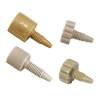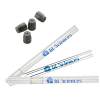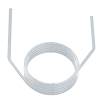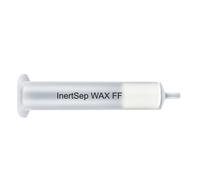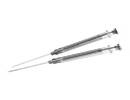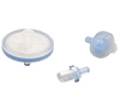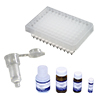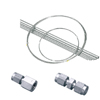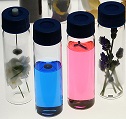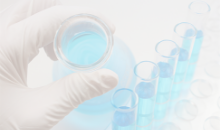3. How to Increase Retention
When your analytes are hardly retained, it is likely that impurities overlap your analytes in real sample analysis even if well separated peaks are obtained with the standards. In this chapter, some tips to increase retention in reversed phase mode are provided.
3-1. Decreasing the Elution Strength of the Mobile Phase
In reversed phase mode, the lower the organic content in the mobile phase is, the longer the analytes are retained in the column. It is recommended to use a mobile phase composition which provides retention factors (k’) ranging from 2 to 10 for your analytes in isocratic mode.

Using 100% water as the mobile phase
For highly hydrophilic compounds, using 100% water as the mobile phase without organic solvents may increase the retention in ODS columns. However, note that some ODS columns are not compatible with 100% water.* Well end-capped columns such as InertSustain AQ-C18, InertSustain C18 and Inertsil ODS-3 can be used with 100% water.

* It is well known that using ODS columns with 100% water or similar mobile phases can cause unstable elution times because the mobile phase comes out from the mesopores of the packing material.
Experimental procedure:
1)Deliver 100% water for 60 min.
2)Analysis (see the chromatograms above).
3)Stop the flow for 15 min.
4)Deliver the mobile phase for 30 min.
5)Stop the flow for 15 min.
6)Analysis (see the chromatograms above).
3-2. Changing the pH of the Mobile Phase
The retention times of ionic compounds can be significantly changed by adjusting the pH of the mobile phase. In reversed phase mode, ionic compounds are more retained at pHs where analytes are not dissociated or protonated. For example, a basic compound possessing an amino group can be more retained by increasing the pH of the mobile phase. In the chromatograms below, the higher pH of the mobile phase is allowed by using an ODS column compatible with basic conditions. This enables the increase in the organic content in the mobile phase, improving the sensitivity in LC/MS/MS while keeping the retention times.

3-3. Increasing the Carbon Load
In general, the carbon load corresponds to the density of the functional groups bonded to the silica surface. For ODS columns, the higher the carbon load is, the more densely ODS groups are bonded to the silica surface. This results in stronger hydrophobic retention. The effect of the carbon load on the retention is more pronounced for hydrophobic compounds.

3-4. Increasing the Surface Area of the Packing Material
The larger the surface area of the packing material is, the stronger the retention becomes because there are more sites on the surface for the interaction. This retention increase by the surface area is effective to almost all compounds unlike the retention increase by the carbon load.

3-5. Using an Ion-pairing Reagent
Ionic compounds are hardly retained in reversed phase mode when they are ionized. When pH adjustment of the mobile phase is not sufficient to deionize your analytes, adding an ion-pairing reagent to the mobile phase can be an option to retain your ionic analytes.

3-6. Changing the Separation Mode
In some cases where analytes are not retained, changing the separation mode is effective. In general, it is difficult to retain hydrophilic compounds in reversed-phase mode. For example for sugars, improving the retention in reversed-phase mode is difficult even with an ion pair reagent. In such a case, the separation has to be carried out not in reversed-phase but in HILIC or ion-exchange mode.



